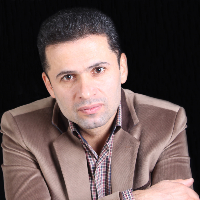Hypertextual Reading of Qasim’s Battle Paintings in Qajar Religious Illustrations (With Emphasis on Mirza Ali Qoli Khoei’s Illustrations)
The battle of the Qasim is a common issue among the Guilan holy shrine paintings, religious paintings, the coffee house paintings and the images of the lithographed books. In the following research with the emphasis on Genette's transtextuality theory, it has addressed the hypertextuality reading among the paintings of Qasim’s battles in Guilan holy shrine paintings, compared to the illustrations of Mirza Ali Qoli Khoei’s lithography, coffee house painting and reverse glass painting .In hypertextuality, the relationship of a text to its pre-written texts gets analysed. The main question of this research is; what effective pretextuality existed among Illustrations of Qasim's battle, the holy shrine paintings, the coffee house paintings and the Ali Qolii Khoei's illustrations? Also, what kind of hypertextuality changes exist among the Qajar religious paintings with the issue of the Qassim’s battle? The following research is done in descriptive-analytic methods and the method of collecting the content is library through taking notes and studying pictures. Data analysis also carried out qualitatively. In the following research, historical narratives along with the first available texts related to the Qasim's battle, as the first pretext, includes historical narratives and Hadiths to the seventh A.H. century and in the second pretext of the book, Rawdat al-shuhada as the veiled text in Guilan holy shrine paintings, the religious reverse glass paintings, coffee house paintings and Khoei's illustrations (illustrated lithographed books) are considered; later in text the adaptation and analysis of written symbolic system to the pictorial systems have been addressed, in the meantime it analyses the transtextuality relations in these paintings.According to the studies, religious reverse glass paintings are the oldest pictorial pretext among these kinds of pictorial arts.After that, the coffee house paintings and Guilan holy shrine paintings, respectively, are illustrated pretexts and Ali Qoli Khoei's illustrations. Therefore, the explicit intertextuality can be seen among the Qajar religious illustrations. The Qasim's battle with Azraq and his sons are one of the most common issues among religious paintings. As it appears, a homogeneity relation accompanied with simulated forgery and pastiche, simultaneously with the transtextuality relation in the change of visual permutation contents and forms, exist among the reverse glass paintings, coffee house paintings and Guilan holy shrine paintings.The visual symbols used in the Khoei's works are shaped, based on previous pictorial pretexts, but simultaneously changes in the combination, the type of written content selection, including increasing or reducing content or cutting text and in some cases, different Khoei's motivations have created a new sign system. Because in the lithographed version, text and image simultaneously have caught the audience’s eyes; there has been more references to written texts in Khoei's illustration than other pretexts. The way of communication in the hypertextuality in textual and pictorial system includes the use of patterns derived from the text of the Hadith and preaching in illustration of the main characters, especially the type of portraying and representing the hostile and innocent characters in a homogeneous way include imitation. Transtextuality between text and image in the pretext and hypertext includes sketch of motives and avolition and hetero motive. It can be said that based on importance and interest, he sometimes repeats, omits or imitates with a different motive or even changes it. The syntactic selection of the basic written text and its use in Khoei's works has similarities with the Guilan holy shrine paintings, whether from the aspect of the motivation or visual signs. As it appears, the extension of the elements in the background has expanded by the extension of its range that is related to the subject and reveals Khoei’s attention to the written pretext. Content wise, expansion in Khoei's illustrations has an increase compared to Guilan holy shrine paintings with the use of elements including human characters, elements used in the foreground and background, which that is further derived from written pretexts.Pastiche and forgery homogeneous relations can be seen between Qassim’s Images in the Khoei's illustrations and Guilan holy shrine paintings.The pastiche interpretations include small changes in hypertext based on the original text which only has a decorative aspect and with more emphasis on the original text. Also, forgery is a duplication and imitation of pretext which is the cause of the homogeneous relations between Khoei's illustrations and pretexts.Since the text and image in Khoei's works affects the audience, he tried to recreate the written pretext for the audience in constructing and polishing his works; and the text of lithographed illustrations in expressing details have expanded more compared to other Qajar religious illustrations. The reducing permutation of the element in the foreground of Khoei's illustrations has provided a reduction current compared to reverse glass paintings, Guilan holy shrine and coffee house paintings, in Khoei's illustrations, omitting the heads which have been cut and beheaded bodies in foreground has a subjective matter and indicates killing massacre in small scales. In fact, Khoei provided the condition to cut the text by conscious removal of mentioned events in written text and existing elements in pretexts: which has a more subjective matter. Finally, it is concluded that Khoei's illustrations are affected by the reverse glass paintings, the coffee house paintings and Guilan holy shrine paintings and in the meantime based on the suggested evidence, the most influential was Guilan holy shrine paintings. In both categories of these paintings, the presence of the written text of Rawdat Al-Shuhada is more tangible than other samples. Also, the type of characterisation, the figures’ body, the delineation, the compositions and the selection of the elements of the narrative in the samples from the Guilan holy shrine paintings have many similarities with Khoei's illustrations.
- حق عضویت دریافتی صرف حمایت از نشریات عضو و نگهداری، تکمیل و توسعه مگیران میشود.
- پرداخت حق اشتراک و دانلود مقالات اجازه بازنشر آن در سایر رسانههای چاپی و دیجیتال را به کاربر نمیدهد.




